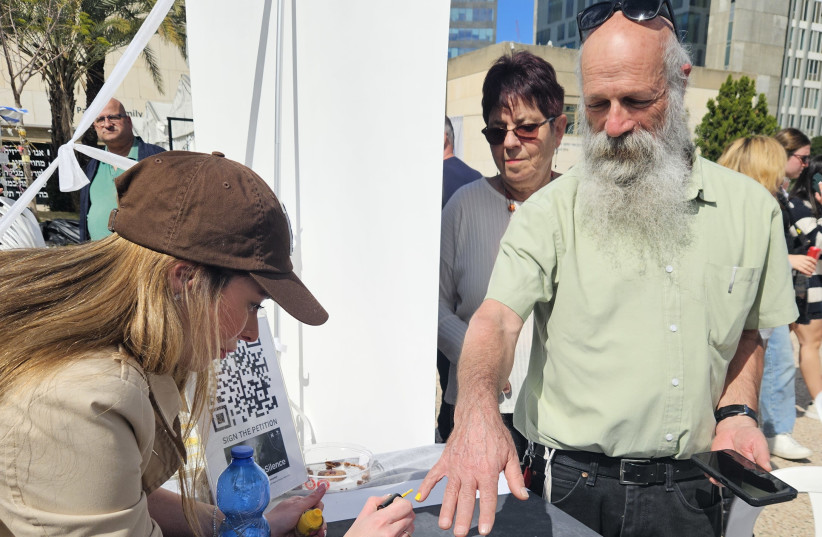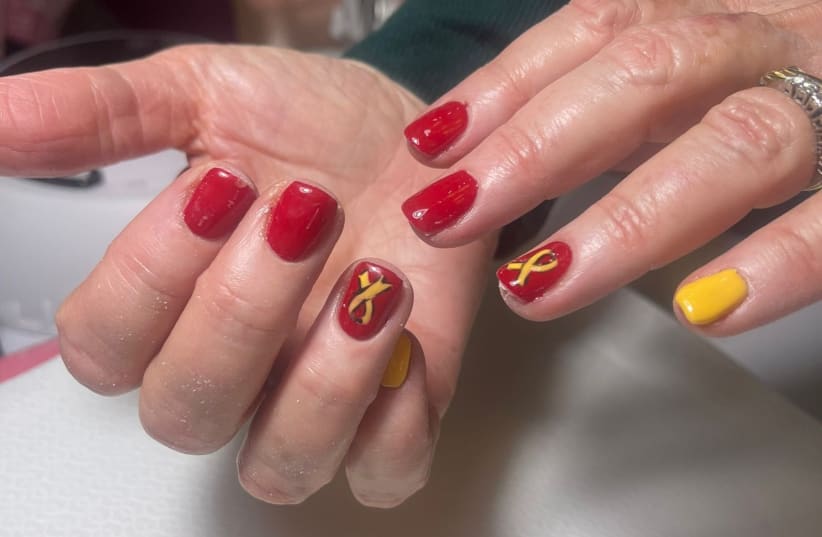It’s a pinky-sized gesture, but when my fingers are typing, cooking, or touching a loved one, I see the yellow nail polish, and it reminds me of the murdered and the hostages.
I’m a grandmother and not particularly cool. No funky nail polish; it’s never blue, black, or with purple sprinkles.
But since January, I’ve had two nails on each hand dedicated to remembering the hostages and the brutally slain. My pinkies are plain yellow, the color of lemons. The ring fingers bear the yellow ribbon of the hostage release campaign.
Please – let us not turn the release of our hostages into a political issue. Every Israeli and anyone around the world with a heart is praying and waiting for the hostages to be freed. We go to sleep checking, and we wake up in the middle of the night checking, and first thing in the morning we’re checking… hoping that while we’ve been sleeping, we’ve missed good news from Gaza.
I still wear the dog tags and the yellow ribbon pins with the symbol, but the manicure means even more. Here’s why.

Nail polish and the Gaza hostages
Nail polish has taken on significance since I heard Shari Mendes speak. Shari is an architect who made aliyah from the United States with her husband, David. They have four children. I heard her first on Zoom speaking for the UN, then testifying in Geneva, and in person at a Hadassah Solidarity Mission. In 2010, after a routine check-up, Shari was diagnosed with breast cancer. That happened on Tisha B’av, the Hebrew date when the two Jerusalem Temples were destroyed. While being treated, she became aware of the financial strain on cancer patients, so she founded and directed the philanthropic fund to help other breast cancer patients with non-medical expenses. She calls it the Lemonade Fund. Most of the website is yellow, too.
Shari is also a member of the IDF’s reserve unit at the Shura army rabbinate base, where soldiers are brought after death. Only women touch the bodies of women soldiers; Shari, an observant Jew, has been trained in all the steps of accompanying women soldiers through the identification process and preparing them for burial. On Oct. 7, the IDF called her to report with her unit for duty the following day. The army and volunteers were still searching for bodies, making sure the dead weren’t kidnapped.
As part of the team, Shari worked to piece together the dismembered women’s bodies. As the weeks went on, the bodies increasingly arrived, covered with maggots and buzzing with flies. She and her co-workers occasionally left the room, fearing the bodies were booby-trapped and ready to explode.
Hers was horrifying, harrowing, but holy work.
Because she’s an architect, Shari is particularly sensitive to color. The dominant dark hues at Shura were black, brown, and green. But suddenly, she said, there was a flash of bright color. The women soldiers had prepared for the Simchat Torah Shabbat by polishing their nails – pink, red, blue, and silver.
Shari’s description of the violated women’s bodies has been a key part of the testimony corroborating the systematic sexual violence perpetrated on women and men on Oct. 7 and later on the hostages. Usually a private person, her willingness to report her experience has made her a target of attack by the evil massacre-deniers of the world.
It was hard to breathe just listening to her testimony, and beyond imagination to picture the mountains of bodies and the sensitive work that needed to be done to prepare them for burial.
Sitting in the audience to my right when Shari spoke was Madelaine Black, a British-born marketing expert. Like Shari, Madelaine is a mother of four. Since the war began, she and her husband, Robert, have hosted dozens of groups of displaced persons, war widows, and hostage families at their home.
When she stood up after Shari’s emotional lecture, Madelaine said, ”We need to polish one of our nails yellow.”
That’s where it started.
(Full disclosure: Both Mendes and Black are my friends, I feel privileged to say.)
Within days, I had a manicure. So did Madelaine, who also came up with a plan to publicize the idea.
Not everyone agreed with the strategy. A man in public relations thought it was just the opposite of what should be done because “women have worked so hard to get away from superficial perception.” He didn’t understand the special connection between women and manicures.
Shari spoke of how moved she and the other women were for those young women preparing for the holiday and thinking of all the good things and what they would do. “It was a sign of hope.”
When I told manicurist and aesthetician Anael Toledano, who runs the nail salon at Hadassah Ein Kerem Hospital, why I suddenly wanted yellow nails, she understood immediately. Working in the hospital every day, she sees new mothers, cancer patients, and terror survivors, in addition to the medical staff, who find comfort and optimism when she listens to their stories and polishes their nails. Her anecdotal but vast experience is reinforced by research published last October (!) in the medical journal Frontiers of Psychology. According to the researchers, nail care, whether done at a salon or at home, can boost positive emotions and relaxation among women. The depth of personal sharing during manicure appointments also enhances these psychological effects. The study was authored by Atsushi Kawakubo and Takashi Oguchi in Japan.
Anael insisted on drawing the three-dimensional yellow ribbon on my ring fingers.
Nearly every day, someone asks me about the nail polish. It’s a chance to tell Shari’s story, to honor the dead, and to remind us all that the hostages are still imprisoned.
From this start, we at Hadassah in Israel launched Madelaine’s proposed campaign, tweaked to an Israeli version, called, in Hebrew, sholfot tzipornayin, loosely translated as “take out your claws/nails,” but meaning something like ”take off our gloves.” A public relations company launched a video about the campaign. There have been 288,000 views.
We’ve been at Hostages Square twice so far, polishing the nails of hostage families and passersby. With this, we honor the murder victims, the valiant soldiers, the volunteers, the families waiting at home, and the hostages.
I’ll keep mine yellow until the last hostage is home.
It’s just a pinkie-sized gesture, but it keeps me focused.
The writer is the Israel director of public relations at Hadassah, the Women’s Zionist Organization of America. Her latest book is A Daughter of Many Mothers.
